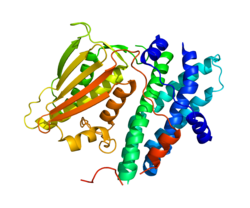Function
The Pyruvate Dehydrogenase (PDH) complex must be tightly regulated due to its central role in general metabolism. Within the complex, there are three serine residues on the E1 component that are sites for phosphorylation; this phosphorylation inactivates the complex. In humans, there have been four isozymes of Pyruvate Dehydrogenase Kinase that have been shown to phosphorylate these three sites: PDK1, PDK2, PDK3, and PDK4. PDK1 is the only enzyme capable of phosphorylating the 3rd serine site. When the thiamine pyrophosphatase (TPP) coenzyme is bound, the rates of phosphorylation by all four isozymes are drastically affected; specifically, the incorporation of phosphate groups by PDK1 into sites 2 and 3 is significantly reduced. [8]
Regulation
As the primary regulators of a crucial step in the central metabolic pathway, the pyruvate dehydrogenase family is tightly regulated itself by a myriad of factors. PDK activity has been shown to decrease in individuals consuming a diet that is high in n-3 fatty acids; however, PDH activity remained unaffected. [9] Additionally, PDK1 is inhibited by AZD7545 and dichloroacetic acid (DCA); the mechanism was discovered to be the trifluoromethylpropanamide end of AZD7545 projecting into the lipoyl-binding pocket of PDK1. Dichloroacetic acid was found near the helix bundle in the N-terminal domain of PDK1. Bound DCA promotes local conformational changes that are communicated to both nucleotide-binding and lipoyl-binding pockets of PDK1, leading to the inactivation of kinase activity. [10]
Clinical Significance
PDK1 is relevant in a variety of clinical conditions throughout the body. As PDK1 regulates the PDH complex, it has been proven to be an important regulator in certain cells, including the beta cells within the islets of the pancreas. In order to optimize glucose-stimulated insulin secretion (GSIS), a primary function of the pancreas, a low PDK1 activity must be maintained to keep PDH in a dephosphorylated and active state. [11] Maintaining low PDK1 levels has also proven to be beneficial in certain regions of the brain, as it confers a high tolerance to amyloid beta, a metabolite that is directly correlated with the development of Alzheimer's disease. [12]
Cancer
The ubiquitous role of this gene lends itself to being involved in a variety of disease pathologies, including cancer. PDK1 mRNA expression is significantly associated with tumor progression; in fact, the presence of PDK1 can serve as a prognostic marker, indicating the level of success a patient can achieve. Specifically, this may serve as a biomarker in patients with gastric cancer. In coordination, the inhibitor dichloroacetic acid may be used in the future as a treatment option for patients with this type of cancer. [13] PDK1, as it regulates hypoxia and lactate production, is associated with a poor outcome in patients with head and neck cancer. [14] [15] The buildup of glycolytic metabolites may promote Hypoxia-Inducing Factor (HIF) activation, which creates a feed-forward loop for malignancy progression. As such, using HIF-1 as a metabolite to regulate PDK1 is seen as another potential therapy, either on its own or in tandem with other therapies, for this type of cancer. [16] [17] In a further developed study, combined PDK1 and CHK1 inhibition was shown to be required to kill glioblastoma stem-like cells in vitro and in vivo. [18]
This page is based on this
Wikipedia article Text is available under the
CC BY-SA 4.0 license; additional terms may apply.
Images, videos and audio are available under their respective licenses.





